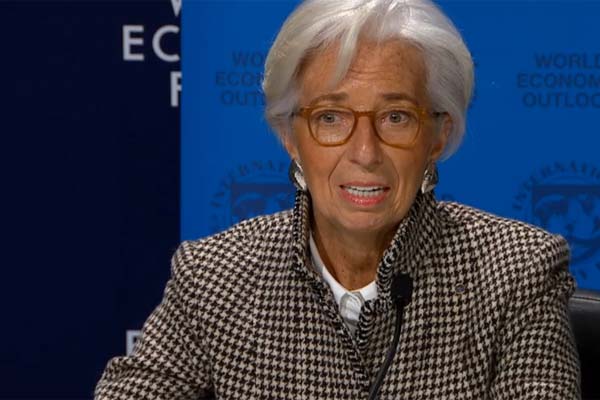
Christine Lagarde
Global growth forecast revised up; to hit 3.9pc, says IMF
DAVOS, January 22, 2018
Global economic activity continues to firm up with global output estimated to have grown by 3.7 percent in 2017, which is 0.1 percentage point faster than projected in the fall and ½ percentage point higher than in 2016, said IMF's World Economic Outlook Update.
The pickup in growth has been broad-based, with notable upside surprises in Europe and Asia.
Global growth forecasts for 2018 and 2019 have been revised upward by 0.2 percentage point to 3.9 percent. The revision reflects increased global growth momentum and the expected impact of the recently approved US tax policy changes said the report released in Davos at the World Economic Forum.
For the two-year forecast horizon, the upward revisions to the global outlook result mainly from advanced economies, where growth is now expected to exceed 2 percent in 2018 and 2019. This forecast reflects the expectation that favourable global financial conditions and strong sentiment will help maintain the recent acceleration in demand, especially in investment, with a noticeable impact on growth in economies with large exports.
Growth in the Middle East, North Africa, Afghanistan, and Pakistan region is also expected to pick up in 2018 and 2019, but remains subdued at around 3½ percent. While stronger oil prices are helping a recovery in domestic demand in oil exporters, including Saudi Arabia, the fiscal adjustment that is still needed is projected to weigh on growth prospects.
Launching the report, Christine Lagarde, Managing Director, International Monetary Fund, said: "Global growth has been accelerating since mid-2016, and all signs point to a further strengthening both this year and next. This is very welcome news.
"However, there are still far too many people left out from the recovery. In fact, about one fifth of emerging markets and developing countries saw their per capita incomes decline in 2017," she said.
Lagarde said while growth is higher, it is mostly cyclical. Absent reforms, the fundamental forces that had us worried about the “new mediocre” – and future growth potential – will remain in place, she said.
Emerging and developing Asia will grow at around 6.5 percent over 2018–19, broadly the same pace as in 2017. The region continues to account for over half of world growth. Growth is expected to moderate gradually in China (though with a slight upward revision to the forecast for 2018 and 2019 relative to the fall forecasts, reflecting stronger external demand), pick up in India, and remain broadly stable in the Asean - 5 region.
The cyclical upswing underway since mid-2016 has continued to strengthen. Some 120 economies, accounting for three quarters of world GDP, have seen a pickup in growth in year-on-year terms in 2017, the broadest synchronised global growth upsurge since 2010. Among advanced economies, growth in the third quarter of 2017 was higher than projected in the fall, notably in Germany, Japan, Korea, and the United States.
Key emerging market and developing economies, including Brazil, China, and South Africa, also posted third-quarter growth stronger than the fall forecasts. High-frequency hard data and sentiment indicators point to a continuation of strong momentum in the fourth quarter. World trade has grown strongly in recent months, supported by a pickup in investment, particularly among advanced economies, and increased manufacturing output in Asia in the run up to the launch of new smartphone models. Purchasing managers’ indices indicate firm manufacturing activity ahead, consistent with strong consumer confidence pointing to healthy final demand.
The US tax policy changes are expected to stimulate activity, with the short-term impact in the US mostly driven by the investment response to the corporate income tax cuts.
Risks to the global growth forecast appear broadly balanced in the near term, but remain skewed to the downside over the medium term. On the upside, the cyclical rebound could prove stronger in the near term as the pickup in activity and easier financial conditions reinforce each other, the report said.
On the downside, rich asset valuations and very compressed term premiums raise the possibility of a financial market correction, which could dampen growth and confidence. A possible trigger is a faster-than-expected increase in advanced economy core inflation and interest rates as demand accelerates. If global sentiment remains strong and inflation muted, then financial conditions could remain loose into the medium term, leading to a buildup of financial vulnerabilities in advanced and emerging market economies alike. Inward-looking policies, geopolitical tensions, and political uncertainty in some countries also pose downside risks, it said.
The current cyclical upswing provides an ideal opportunity for reforms. Shared priorities across all economies include implementing structural reforms to boost potential output and making growth more inclusive. In an environment of financial market optimism, ensuring financial resilience is imperative, the report said.
Commodities and inflation
An improving global growth outlook, weather events in the US, the extension of the Opec+ agreement to limit oil production, and geopolitical tensions in the Middle East have supported crude oil prices. These have risen by about 20 percent between August 2017 and mid-December 2017, to over $60 per barrel, with some further increase as of early January 2018. Markets expect prices to gradually decline over the next 4–5 years. The increase in fuel prices raised headline inflation in advanced economies, but wage and core-price inflation remain weak. Among emerging market economies, headline and core inflation have ticked up slightly in recent months after declining earlier in 2017. - TradeArabia News Service







